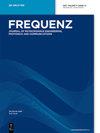用于个人作用无线电应用的宽带双模天线共享辐射器设计
IF 1
4区 工程技术
Q4 ENGINEERING, ELECTRICAL & ELECTRONIC
引用次数: 0
摘要
摘要 针对个人作用无线电(PRR)应用,介绍了一种同时覆盖 VHF/UHF 波段和卫星导航波段的宽带双模天线的共用辐射器设计。四叉螺旋天线(QHA)被设计成圆极化辐射器,同时作为偶极子天线上半辐射臂的一部分,相当于 VHF/UHF 波段的线性极化辐射载流子,形成正弦电流分布的对称偶极子天线。为获得尽可能大的工作带宽,采用了由五个级联 L 段组成的五阶平衡匹配网络,在 VHF/UHF 频段实现了 3.76:1 的带宽(116%)。由于采用了 QHA 共辐射器设计,在 1.5 GHz 附近观察到了两种工作模式的强烈相互耦合效应,并采用了一种新的平衡器结构来实现高隔离和自去耦,从而在不影响反射系数和辐射效率的情况下,将两种工作模式的|S21|从卫星导航频段的-18 dB 左右显著降低到-32 dB 以下。测量结果表明,制造原型的辐射模式与相应的模拟模式基本一致。本文章由计算机程序翻译,如有差异,请以英文原文为准。
Shared-radiator design of broadband and dual-mode antenna for personal role radio applications
Abstract Shared-radiator design of a broadband and dual-mode antenna that simultaneously covers the VHF/UHF band and satellite navigation band is presented for personal role radio (PRR) applications. Quadrifilar helix antenna (QHA) is devised to be a circularly polarized radiator which as well acts as a part of the upper half radiation arm of the dipole antenna and be equivalent to a linearly polarized radiation current carrier at VHF/UHF band, forming a symmetrical dipole antenna with a sinusoidal current distribution. A 5th-order balanced matching network comprised of five cascade L-sections is adopted to obtain the maximum possible working band-width and a 3.76:1 band-width (116 %) at VHF/UHF band is achieved. Strong mutual coupling effect of the two operating modes is observed near 1.5 GHz originated from QHA shared-radiator design, and a new balun structure is applied to achieve high isolation and self-decoupling, subsequently |S21| of the two operating modes is significantly reduced from about −18 dB to below −32 dB at satellite navigation band without affecting the reflection coefficient and radiation efficiency. The measured results show that radiation patterns of the manufactured prototype is basically consistent with corresponding simulation counterparts.
求助全文
通过发布文献求助,成功后即可免费获取论文全文。
去求助
来源期刊

Frequenz
工程技术-工程:电子与电气
CiteScore
2.40
自引率
18.20%
发文量
81
审稿时长
3 months
期刊介绍:
Frequenz is one of the leading scientific and technological journals covering all aspects of RF-, Microwave-, and THz-Engineering. It is a peer-reviewed, bi-monthly published journal.
Frequenz was first published in 1947 with a circulation of 7000 copies, focusing on telecommunications. Today, the major objective of Frequenz is to highlight current research activities and development efforts in RF-, Microwave-, and THz-Engineering throughout a wide frequency spectrum ranging from radio via microwave up to THz frequencies.
RF-, Microwave-, and THz-Engineering is a very active area of Research & Development as well as of Applications in a wide variety of fields. It has been the key to enabling technologies responsible for phenomenal growth of satellite broadcasting, wireless communications, satellite and terrestrial mobile communications and navigation, high-speed THz communication systems. It will open up new technologies in communications, radar, remote sensing and imaging, in identification and localization as well as in sensors, e.g. for wireless industrial process and environmental monitoring as well as for biomedical sensing.
 求助内容:
求助内容: 应助结果提醒方式:
应助结果提醒方式:


